
Consonants and Vowels – 2 Popular Categories in English Phonics
The English Language has 44 English sounds. They can be divided into two main categories: consonants and vowels. A consonant sound is a sound where the airflow is stopped, either partially or completely, when the sound is uttered.
On the other hand, a vowel sound is a sound where the airflow is unstopped when the sound is produced. The vowel sounds are the rhyme or shift of our language. Monophthongs and diphthongs are the two categories of vowel sounds. Vowel sounds are also divided into long vowel sounds and short vowel sounds.
In English, a, e, i, o, u, and sometimes y are the vowel letters. The rest of the letters in the alphabet represent consonants such as b, d, g, n, r, s, and t. some consonants produce more than one sound.
Table of Contents
- What is a Vowel
- Monophthong
- Diphthongs
- Long and Short Vowel Sounds
- What is a Consonant
- Consonant Digraphs
- Consonant Blends
- Consonant Clusters
- Place and Manner of Articulation of Consonants and Vowels
- Some Fun Activities for Learning Vowels and Consonants
- F.A.Q Consonants and Vowels
- Conclusion
What is a Vowel?
A vowel is a speech sound where the mouth is open and the tongue doesn’t touch the top of the mouth, the teeth, etc. so that the flow of air is not limited. A vowel is a sound made by blowing air out of the mouth without closing your mouth or teeth. It is the louder sounding part of a word. It is necessary to know that there is a difference between a vowel sound and a vowel letter in the alphabet.
The English vowel sounds are written with letters in the English alphabet. All English words have vowel letters. They are vowels in English: A, E, I, O, U, and sometimes Y. Y is “sometimes” a vowel because the letter Y presents both vowel and consonant sounds, like ‘fry’.
Six vowel letters are used to indicate the 13-15 vowel sounds in English. This means the vowel sounds are more than letters in the English alphabet. Monophthongs and diphthongs are the two main categories of vowel sounds.
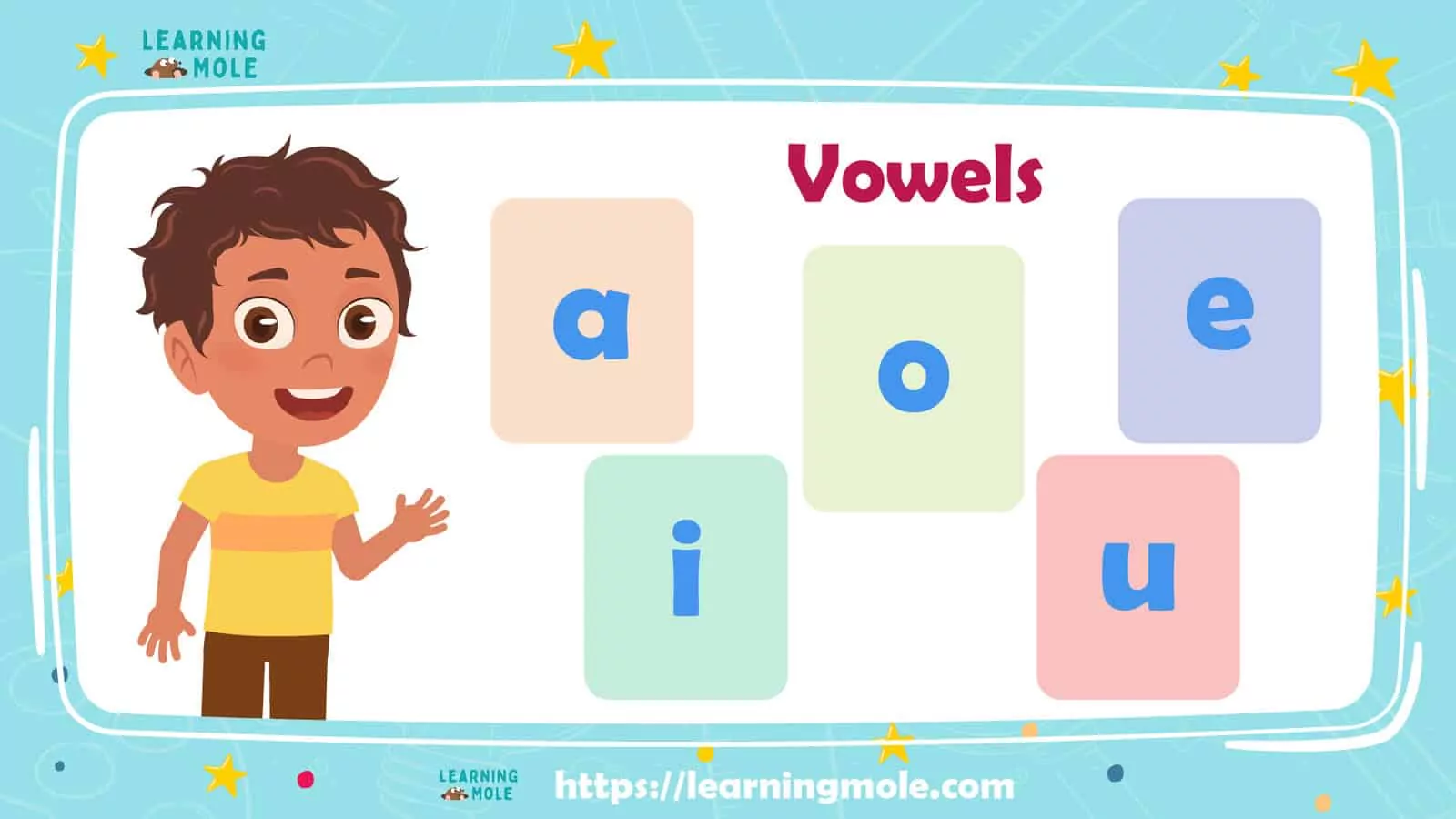
Monophthong
A monophthong is simply a vowel. The word mono represents one and phthong represents a sound. This means that monophthong represents one vowel sound in the word. If you notice the position of the tongue, the mouth will stay the same when these words are uttered.
In English – /i:/, /ɪ/, /ʊ/, /u:/, /e/, /ə/, /ɜ:/, /ɔ:/, /æ/, /ʌ/, /ɑ:/ and /ɒ/ are 12 pure vowels or monophthongs. let’s check the list of 12 pure vowel sounds with some examples
|
Sound |
Examples |
|
/i:/ |
heap, leap, feet, seat, read, beat, peak, seek |
|
/ɪ/ |
lift, hit, kit, pick, bill, fill, till, him, pin |
|
/ʊ/ |
Food, Fool, Cool, Cook, look |
|
/u:/ |
To, You, New, Who |
|
/e/ |
Bet, Met, Pet, Set, Bend, Lend, Send |
|
/ə/ |
The, About, Could, Us |
|
/ɜ:/ |
Earl, Pearl, Sir, Worm, worth |
|
/ɔ:/ |
Mall, Hall, Shall, Fall, Tall, Wall |
|
/æ/ |
hand, Land, Sand, Cat, Mat, Pat, Sat |
|
/ʌ/ |
But, Up, One, Much |
|
/ɑ:/ |
Start, Ask, Large, After |
|
/ɒ/ |
Of, On, From, Not |
Diphthongs
A diphthong is a mix of two vowel sounds or vowel letters, like the sounds /aɪ/ in pipe /paɪp/ or the letters ou in doubt. The part ‘di’ represents two and the other part represents sounds. Although a diphthong has two different vowel sounds, they stay within the same syllable or unit of sound.
The best way to know if a word has a diphthong with two vowel sounds, or a monophthong, is to listen to how it sounds when you say it out loud. If the vowel sound changes within the same syllable, it’s most certainly a diphthong.
Let’s check some examples of diphthongs:
|
long A to long E /eɪ/ |
long I to long E /aɪ/ |
long O to long E /oɪ/ |
long E to Ur /i/ |
long A to Ur /e/ |
short A to long U /aʊ/ |
long O to long U /oʊ/ |
|
play |
cry |
soil |
Peer |
Bear |
clown |
clow |
|
Eight |
pie |
Enjoy |
Hear |
Hair |
how |
boat |
|
clay |
Eye |
boy |
Steer |
Wear |
brown |
Toe |
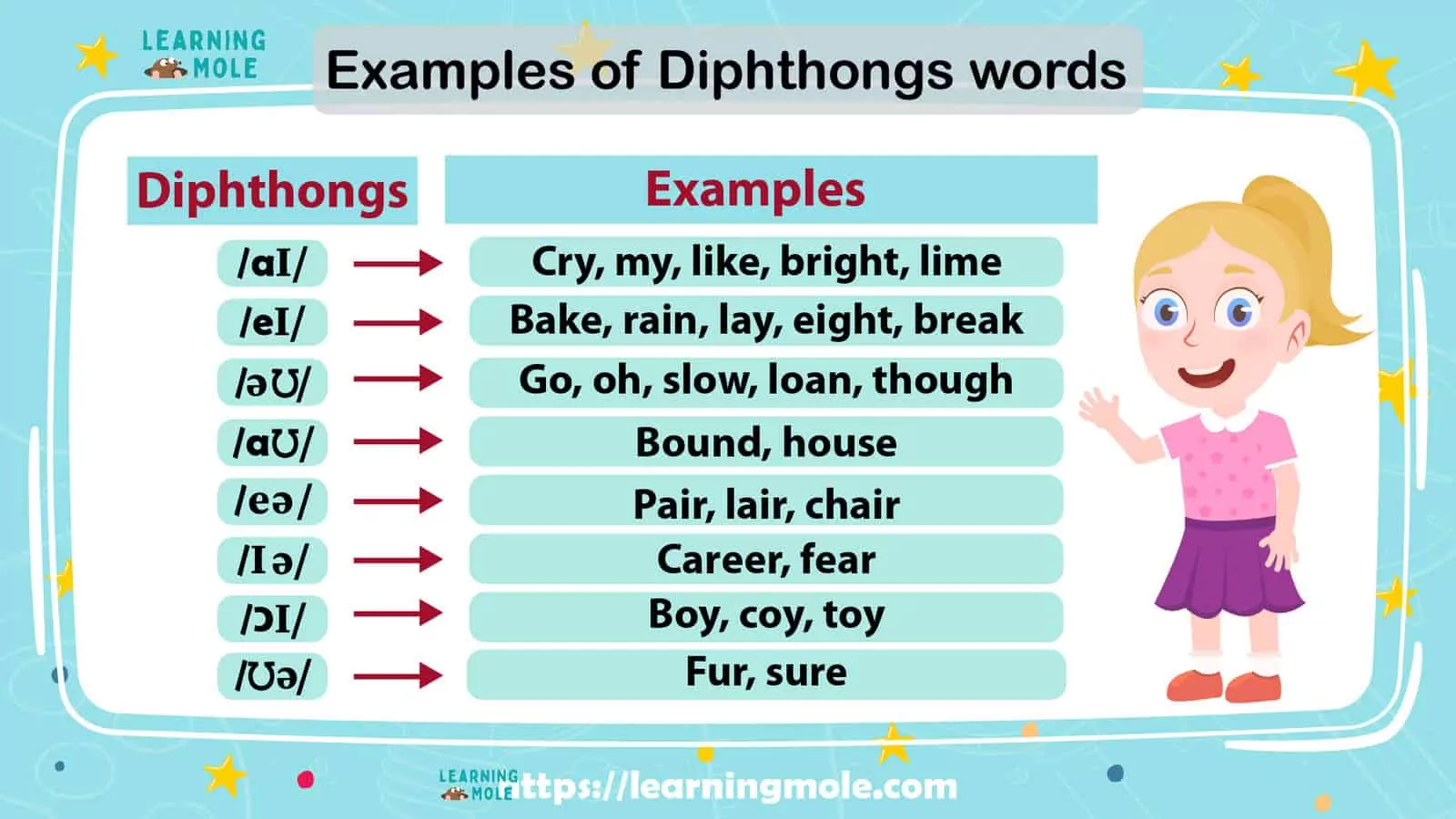
Long and Short Vowel Sounds
The sounds of the letters of the English alphabet can somehow vary. In some cases, it can get tricky. Not all letters produce the same sound in all words. The letters can have different sounds according to how they are used.
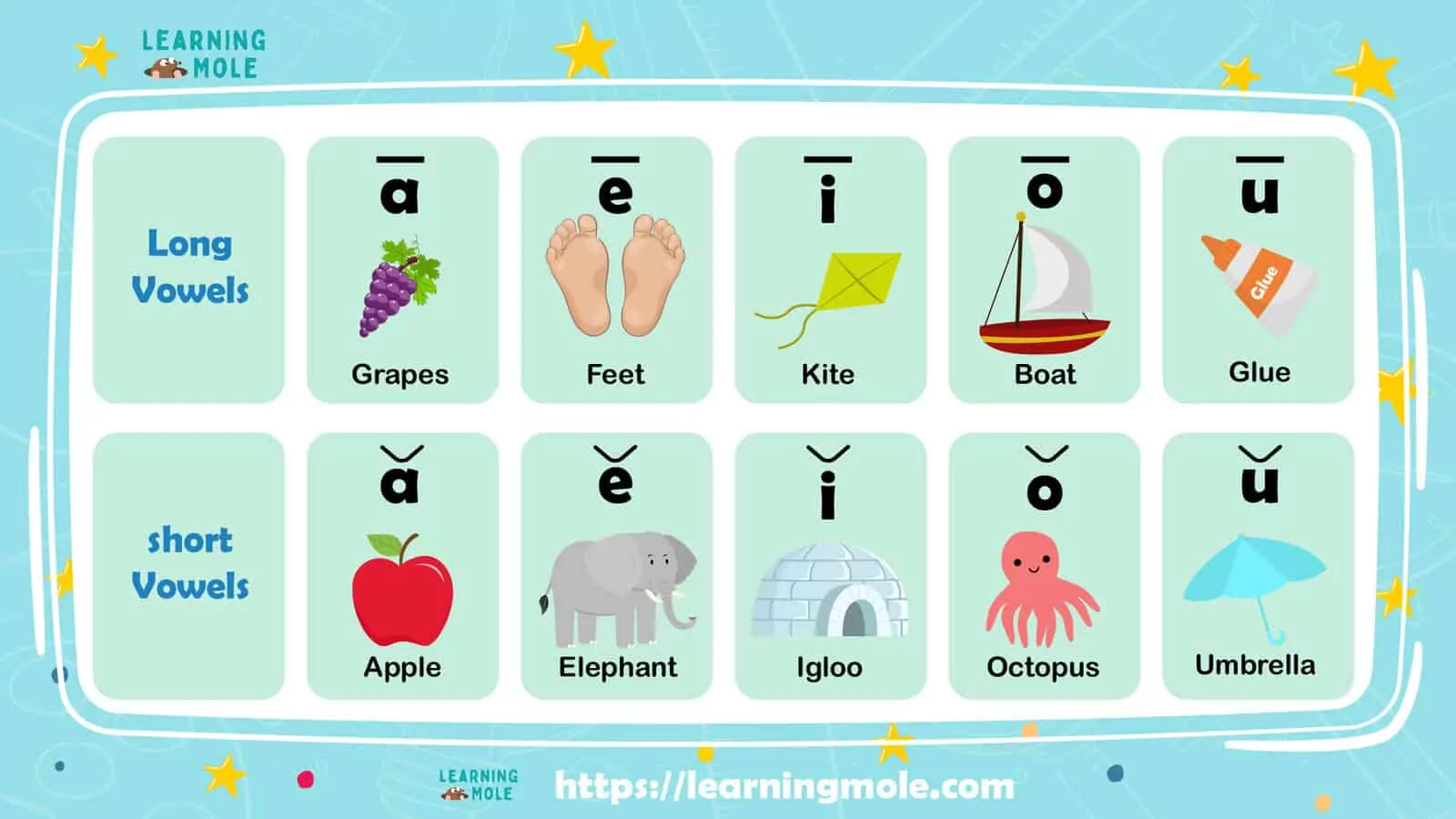
The most popular sound for each vowel is its “short” sound. The short ă, pronounced /æ/ as in hat. The short ĕ, pronounced /ɛ/ as in bed. The short ĭ, pronounced /ɪ/ as in silk. The short ŏ, pronounced /ɑ/ as in crop. The short ŭ, pronounced /ʌ/ as in mug.
“Long vowels” are the alphabet sounds when the vowel, “says its name”. We call them ‘long’ because we hold them barely longer than short sounds. Yet, they are totally different sounds; They are not a longer version of the same sound.
Long A (ā), pronounced /eɪ/ as in hate or fate. Long E (ē), pronounced /iː/ as in eat or heat. Long I (ī), pronounced /aɪ/ as in kite or night. Long O (ō), pronounced /oʊ/ as in coats, note or coat. Long U (ū), pronounced /juː/ as in cute or /uː/ as in glue.
There are some rules for what sound the vowels make in different examples.
|
Vowel Position |
Vowel Sound |
Examples |
|
If a word has only one vowel and ends with a consonant |
Vowel makes a short sound |
‘a’ in ‘jar’ ‘e’ in ‘nest’ ‘o’ in ‘not’ ‘i’ in ‘kit’ ‘u’ in ‘sun’ |
|
If a word has two vowels separated by two or more letters |
The first vowel makes a short sound |
as in ‘apple’ as in ‘octopus’ as in ‘basket’ as in ‘elephant’ as in ‘umbrella’ |
|
If a word ends with the letter ‘e’ (magic ‘e’/ silent ‘e’) |
The first vowel makes a long sound |
‘hat’ becomes ‘hate’ ‘kit’ becomes ‘kite’ ‘cub’ becomes ‘cube’ as in ‘name’ as in ‘lime’ |
|
If a word has two vowels walking together the first one does the talking |
The first vowel makes a long sound The second vowel remains silent |
as in ‘pie’ as in ‘coat’ as in ‘grain’ as in ‘value’ as in ‘meet’ |
Let’s check the list of the International Phonetic Alphabet (IPA):
|
IPA |
Example |
|
/æ/ |
cat, bad, sad, sand, land, hand |
|
/ɑː/ |
calm, palm, father, start, dark (British English)
grass, can’t, half, bath (American English) |
|
/ɒ/ |
god, pot, top, spot (British English only) |
|
/ʌ/ |
but, cut, gun, come, some, glove |
|
/ɛ/ |
get, bed, set, sell, fell, men |
|
/ɪ/ |
pit, bin, fill, will, village, bullet |
|
/i/ or /iː/ |
he, she, see, keep, family, hyperbole |
|
/ɔː/ |
saw, straw, dawn, fall, call, wall |
|
/ʊ/ |
put, full, good, wood, could, would |
|
/uː/ |
you, who, chew, shoe, cool, tool |
|
/ə/ |
a, syllable, moment, terrible, felony, papyrus |
|
/ɚ/ |
mister, standard, editor (Am. English only) |
|
/ɜː/, /ɝː/ |
curve, purge, herd, serve, |
What is a Consonant
A consonant is a sound that is produced by blocking air from flowing out of the mouth with the teeth, tongue, lips or palate. Consonants may come alone or in clusters but have to be connected to a vowel to form a syllable.
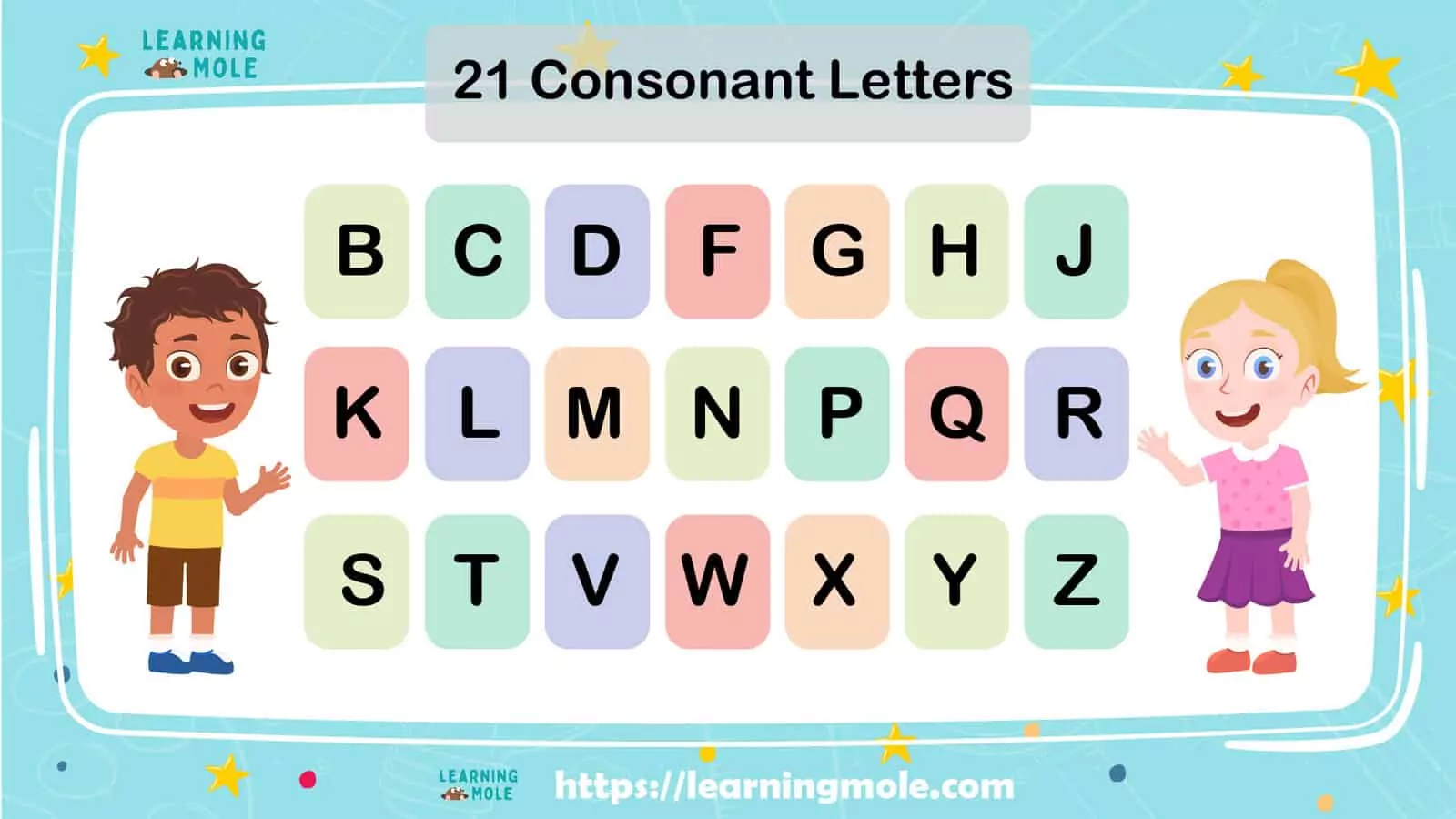
English has 21 consonant letters, for 24 consonant sounds in most English accents: H, J, K, L, M B, C, D, F, G, N, P, Q, R, S, T, V, W, X, Z and (sometimes Y). The letter ‘y’ produces a consonant sound if at the beginning of a word ‘yellow’ but a vowel sound if at the end of a word ‘sunny’.
Consonant Digraphs
Digraphs are two letters that produce just one sound. These are the seven basic consonant digraphs; ch, ck, th, sh, ph, ng, wh. Yet, some digraphs have more than one pronunciation. ‘ghosts’ are some digraphs like ‘wr’ and ‘gn’ because the first letter is not pronounced. Let’s check the list of the digraphs with examples:
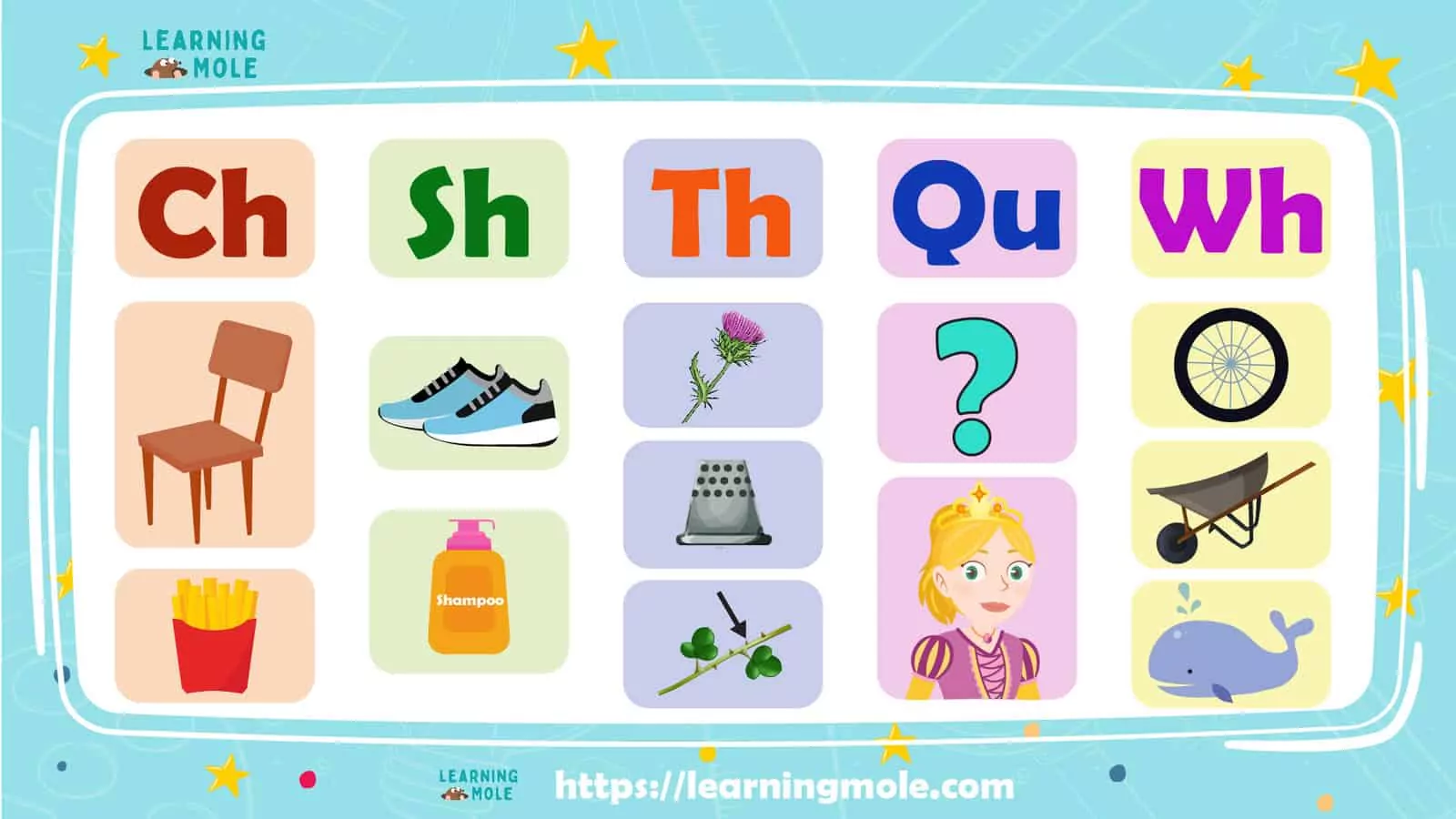
|
Digraph |
Examples |
|
ch |
Makes the sound /t∫/ in Chair , /k/ in chorus and /sh/ in chute |
|
ck |
which makes the sound /k/ sound as in click |
|
ff |
which makes the sound /f/ sound as in stuff |
|
gh |
which makes the sound /g/ sound as in yoghurt or /f/ as in enough |
|
gn |
which makes the /n/ sound as in reign and foreign |
|
kn |
which makes the /n/ sound as in know and knot |
|
ll |
which makes the /l/ sound as in hall |
|
lm |
which makes the /m/ sound as in calm and palm |
|
mb |
which makes the /m/ sound as in dumb and thumb |
|
ng |
which makes the /ŋ/ sound as in ring and hung |
|
ph |
which makes the /f/ sound as in photo, and elephant |
|
sh |
which makes the /ʃ/ sound as in splash and sheet |
|
ss |
which makes the /s/ sound as in less and grass |
|
ss |
which makes the /ʃ/ sound as in assure and issue |
|
th |
which makes the /θ/ sound as in three and myth |
|
th |
which makes the /ð/ sound as in that and them |
|
wh |
which makes the /w/ sound as in where and where |
|
wr |
which makes the /r/ sound as in wreck |
|
zz |
which makes the /z/ sound as in jazz and buzz |
|
dg |
Which makes the sound /ʤ/ as in edge and wedge |
|
ng |
which makes the /nʤ/ sound as angel |
|
nk |
which makes the /ŋk/ sound as in link |
Consonant Blends
A consonant blend occurs when two or more consonants are blended together, yet each sound may be heard in the blend. The most common beginning consonant blends include: pl, pr, sl, sm, sp and st, bl, br, cl, cr, dr, fr, tr, fl, gl, gr. Blends can also appear at the end of words.
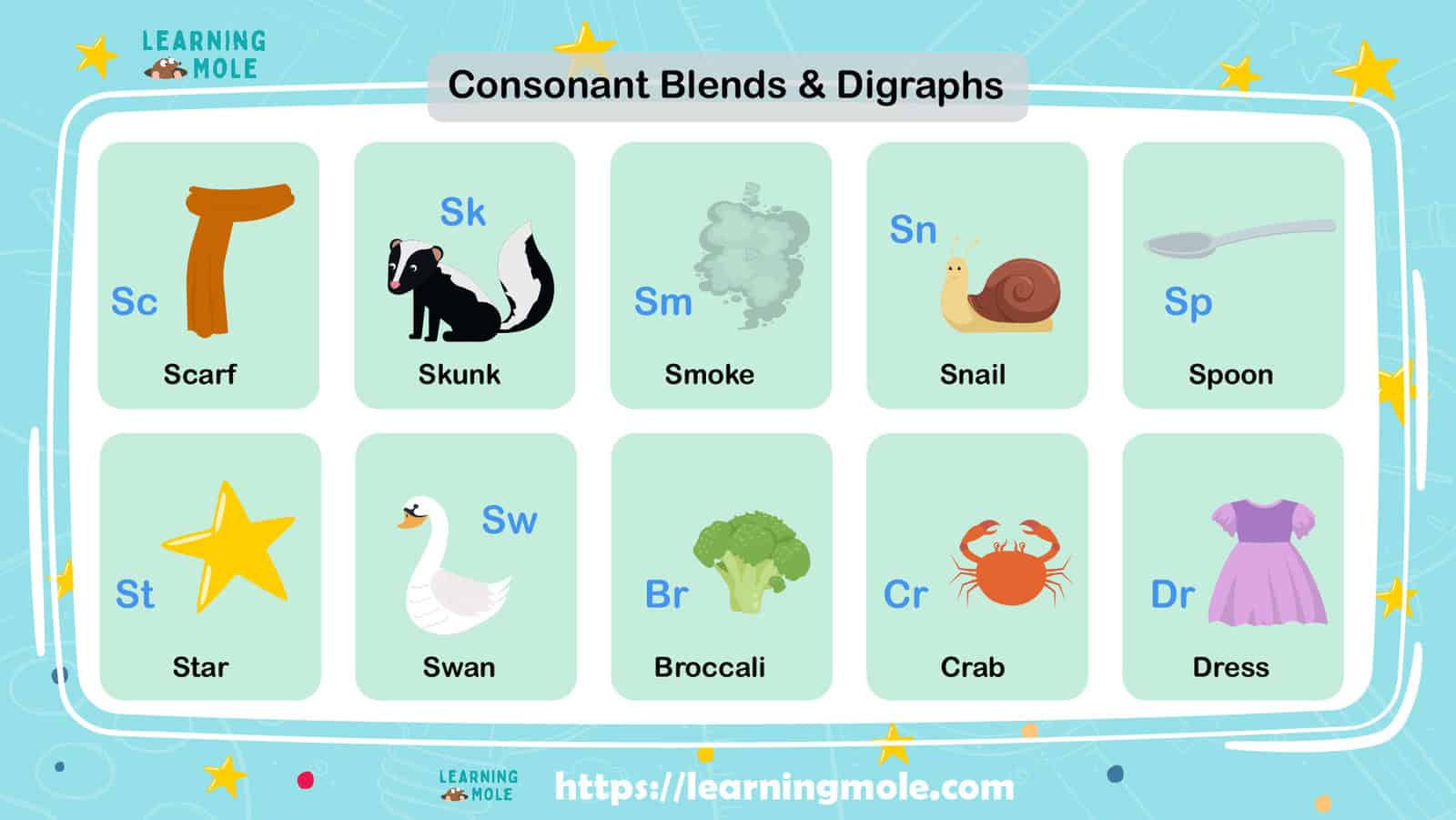
Blends are most of the time categorized into r-blends, such as “br” and “cr”, s-blends, such as “sc” and “sk” and l-blends, such as “bl” and “cl”. There are also blends that include three consonants. Popular three consonant blends include str, spl, and spr.
Let’s check the list of two letters blends
|
blends |
examples |
|
bl |
which make the /bl/ sound as in blend and black |
|
br |
which make the /br/ sound as in bread and brave |
|
cl |
which make the /cl/ sound as in clap and clip |
|
cr |
which make the /cr/ sound as in crab and crew |
|
dr |
which make the /dr/ sound as in drum and drag |
|
fl |
which make the /fl/ sound as in flame and flat |
|
fr |
which make the /fr/ sound as in fresh and frame |
|
gl |
which make the /gl/ sound as in globe |
|
gr |
which make the /gr/ sound as in grammar |
|
nd |
which make the /nd/ sound as in bend |
|
pl |
which make the /pl/ sound as in please |
|
pr |
which make the /pr/ sound as in print and prey |
|
sl |
which make the /sl/ sound as in slim and sleep |
|
sm |
which make the /sm/ sound as in smash |
|
sn |
which make the /sn/ sound as in snail |
|
sp |
which make the /sp/ sound as in spare |
|
st |
which make the /st/ sound as in strange |
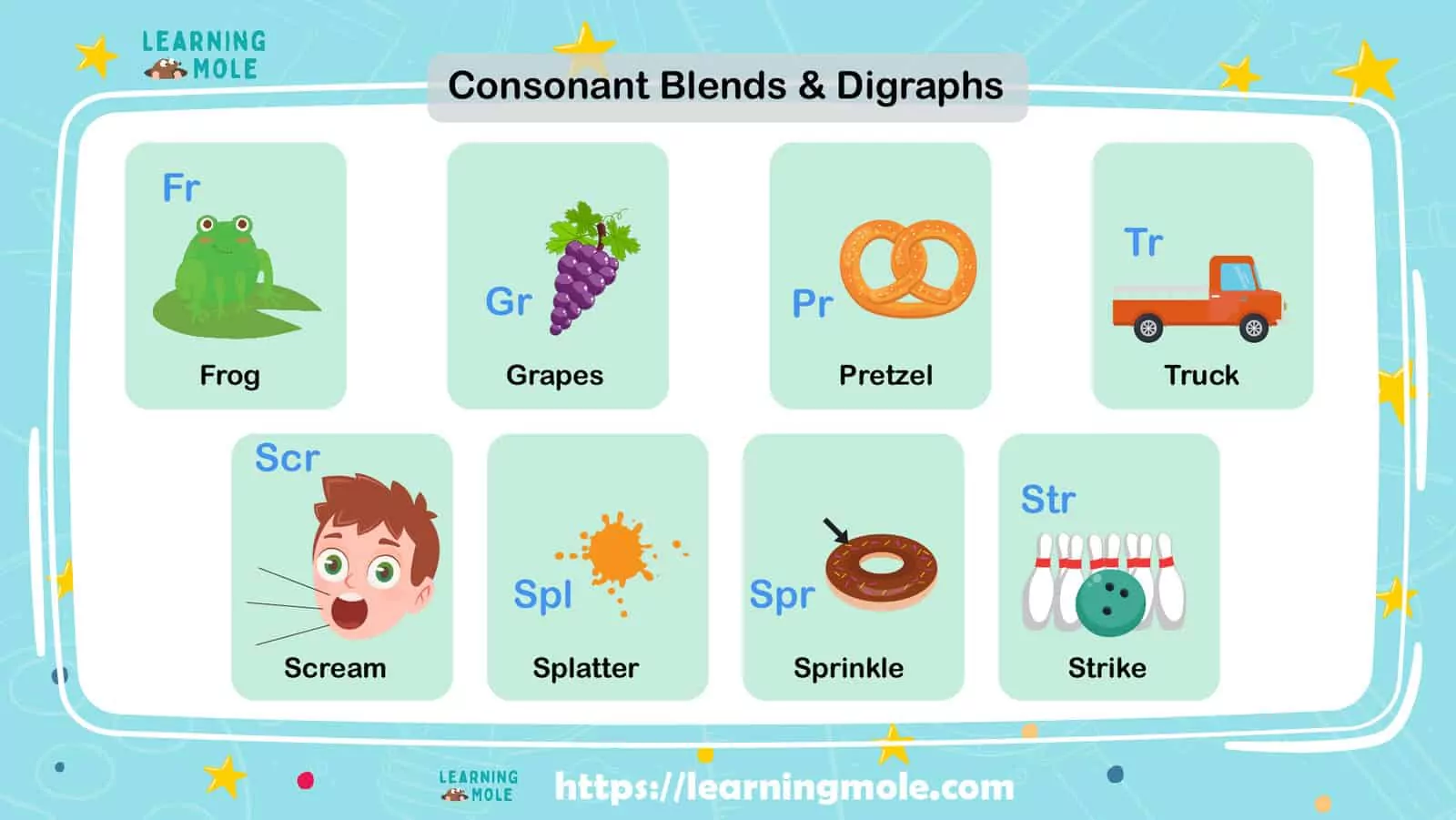
Consonant Clusters
Consonant cluster refers to two or more consonants positioned side by side in a word. They are also called consonant blends. The longest possible cluster in English is three consonant sounds at the beginning. They can be up to four consonants long at the end of the word.
Let’s check the list of consonant clusters examples:
|
Three-letter blends |
examples |
|
shr |
which make the /ʃr/ sound as in shrimp |
|
spl |
which make the /spl/ sound as in splendid |
|
spr |
which make the /spr/ sound as in spread |
|
squ |
which make the /sqw/ sound as in squash |
|
str |
which make the /str/ sound as in string |
|
thr |
which make the /θr/ sound as in threw |
|
lfths |
As in twelfths |
Consonants charts
|
Symbol |
example |
|
/b,(b)/ |
Bin, back |
|
/k,(k)/ |
Cat, key |
|
/ch,(ʧ)/ |
Check, cheese |
|
/d,(d)/ |
Dog, doll |
|
/f,(f)/ |
Fish, fries |
|
/g,(g)/ |
Goat, great |
|
/h,(h)/ |
Hotel, hat |
|
/j,(ʤ)/ |
Bridge. Jigsaw |
|
/l,(l)/ |
Lemon, ballon |
|
/m,(m)/ |
Ment, lamb |
|
/n,(n)/ |
Nest, pen |
|
/ng,(ŋ)/ |
King, ring |
|
/p,(p)/ |
Plenty, hippo |
|
/r,(r)/ |
Rat, wrist |
|
/s,(s)/ |
Sad, dress |
|
/sh,(ʃ)/ |
Shine, splash |
|
/t,(t)/ |
Tent, cart |
|
/th,(θ)/ |
Thin, length |
|
/th,(ð)/ |
There, father |
|
/v,(v)/ |
Vowel, love |
|
/w,(w)/ |
Where, well |
|
/y,(j)/ |
Yet, yellow |
|
/z,(z)/ |
Zero, prize |
|
/zh,(Ʒ)/ |
Measure, television |
What Do You Know about Place and Manner of Articulation of Consonants and Vowels?
Manner of Articulation refers to the “how” of making sounds. There are six different ways or manners of articulation. Place of Articulation refers to the ‘where’ of pronunciation. It is the location where sounds are made. Let’s check the below charts that show the manner and place of articulations of consonants and vowels.
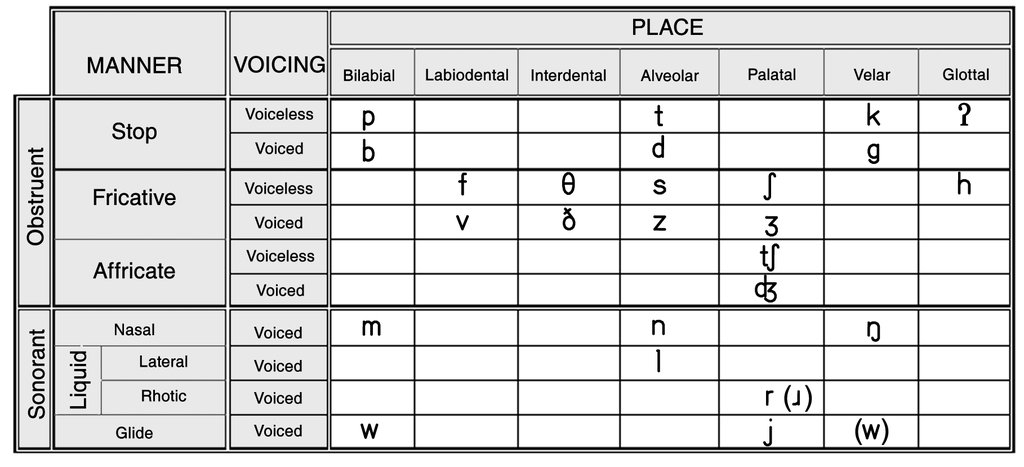
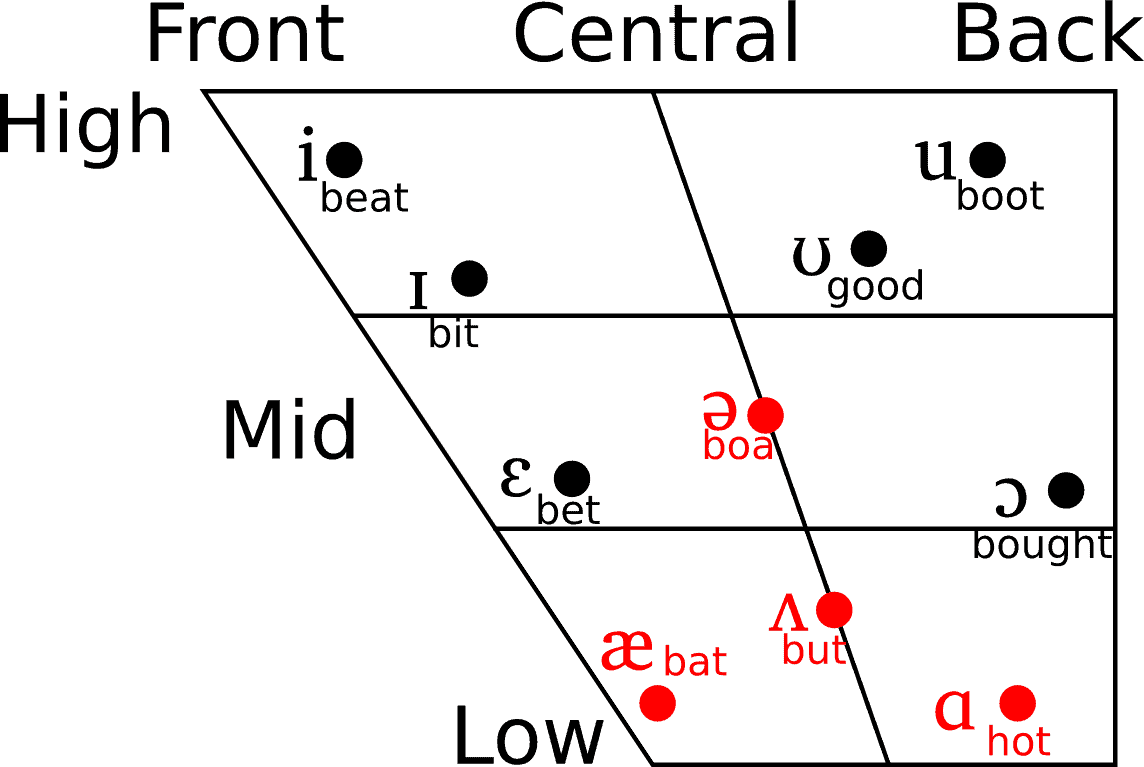
Some Fun Activities For Learning Vowels and Consonants
Short Vowel Craft Stick: Learners take turns to say a word with a short vowel sound out loud. The other learners catch up with the correct sound stick.
Picture Sorts: Students hold cards with the sounds and have to match pictures to the correct sounds.
Short or Long? The teacher says a word out loud, and the students have to know the sound and whether it is short or long.
Bend letters with pipe cleaners: Kids use the pipe cleaners to make consonant sounds.
Find invisible letters with watercolours: Use a white crayon to draw letters on white paper. Provide the kids with watercolour, ask them to paint the paper, and watch the letters appear.
If you have access to a computer or another electronic device, there are a few online games that you could also play to understand the differences between vowels and consonants and recognising real blended words from fake words. Have a look at a few of the online resources that we think you will enjoy;
Phonics play is a great resource with endless games to choose from such as Buried Treasure, Picnic on Pluto, Dragons Den or Pick-A-Picture.
Topmarks is also another great online resource that has games such as Balloon Phonics, Spooky Sounds and Sound Sayer. These are fun and interactive games that will hold your classes or child’s attention while they learn at the same time.
ICT Games is a free online resource that has games like Rapid River, Phonics Pop, Viking Full Circle, Blending Bingo and Help a Hedgehog. These games help with a child’s reading, spelling abilities and to better understand phonics.
F.A.Q on Consonants and Vowels
Why is it important to know vowels and consonants?
Both consonants and vowels are very important in order to pronounce almost every word in the English language. Without vowels or consonants, it’d be impossible for us to talk.
What is the difference between vowels and consonants?
The main difference between vowels and consonants is how the letters are voiced. A vowel is spoken with an open vocal tract, allowing breath to flow out of the mouth, whereas a consonant is spoken with complete or partial closure of the vocal tract.
Do all words have a vowel?
Most English words have vowels, but there are a few words that don’t contain the vowel letters A, E, I, O, or U. It is estimated that there are over 120 words without vowels in the English language. A few examples of words with no vowels are why, hmm, myths, dry, shh and brr.
What is phonics?
Phonics involves matching the sounds of spoken English with individual letters or groups of letters. When learning to read and write at the beginning, children are taught how to pronounce and spell CVC words (consonant, vowel, consonant), examples being cat, dog, top, fit. Once three lettered words are understood, four letter words, CCVC are tackled, such as trap, stop, pram and CVCC words, such as milk, lamp, cart.
Which consonant has multiple sounds?
There are seven consonants in the English language that can have more than one sound. These are C, G, D, S, Y, and X. For example, the letter C can sound like an S (cell, city, cinema) or a K (cat, card, coat). The letter G can make a hard G sound (goat, gory, gate) or a J sound (gel, gem, giant). The letter S can make a soft S sound (sail, safe, snow) or a Z sound (logs, beds, was). It’s important for readers to understand that some consonants make more than one sound so they can pronounce them properly.
Does any word contain all vowels?
Yes, there are some words in the English language that contain all 5 vowels. An example of a word that contains all 5 vowels is “eutopia”. Did you know that Mozambique is the only country in the world which contains all 5 vowels in it.
Can all words be sounded out?
Unfortunately, not all words are phonetic, can be sounded out, these words are known as ‘tricky’ words and they must be memorised. If you try to sound out tricky words you will get a word that does not sound right. Some examples of tricky words are she, into, are, the, you and egg. ‘Tricky’ words can be, well, tricky to pronounce but repetition is the best way to learn them. A simple exercise to teach ‘tricky words is this;
Show the ‘tricky’ word, such as “two” and say it out loud. Put the word into a sentence, for example, “The boy has two dogs”. Then allow the children to make up their own sentences, for example, “I have two sisters”, “John has two cats”. Write the word “two” and keep repeating it with the class. Once children are exposed to the word repeatedly, understand the word and know how to use the word they will begin to memorise it. This is the easiest way to teach and learn non phonetic words.
Conclusion
So, vowels and consonants are the two main categories in the English language. There is no English word that contains more than three consecutive consonants. Each word contains at least one vowel sound. The English language has short vowel sounds and long vowel sounds. The pronunciation of the sounds is produced according to the place and manner of articulation.


It was very refreshing to learn so deeply about vowels and consonants. Thank you so much